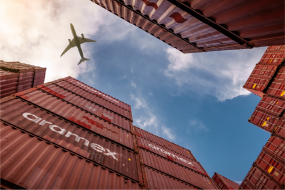In the high-pressure world of aviation and logistics, smooth operations depend on razor-sharp timing, accurate data, and bulletproof coordination. But for too many supply chains, there’s one thing dragging it all down: outdated technology.
From aerospace logistics services to day-to-day aviation supply chains, legacy systems are slowing things down, driving up costs, and blocking real progress. The good news? With the right tools and a future-focused mindset, it doesn’t have to stay that way.
Related Reading: The hidden edge: Logistics tech in engineering
Why Aviation Logistics Needs a Tech Wake-Up Call
Aviation logistics services are more complex than ever. Whether you’re moving aircraft parts, managing MRO (maintenance, repair and overhaul) operations, or handling urgent shipments across continents, there’s no room for error.
But here’s the problem: too many aviation supply chains still rely on outdated systems – think manual processes, fragmented platforms, and tech that just doesn’t talk to each other.
What does that mean in real life? Slower turnaround times, missing visibility, expensive delays, and frustrated customers. In a sector where precision is everything, it’s a serious risk.
Meeting the Challenge: Modernising Aerospace Logistics Services
Managing an aerospace supply chain isn’t for the faint-hearted. The stakes are high, regulations are strict, and expectations are through the roof. Add in legacy systems, and you’ve got a recipe for chaos.
But modern aviation and logistics professionals have more tools than ever at their fingertips. Real-time tracking, AI-driven forecasts, and integrated platforms are helping teams overcome legacy tech and streamline operations across the board.
Related Reading: Is your supply chain holding back production growth?
Tech That’s Rewriting the Rules of Aviation Logistics
IoT and Smart Sensors: See Everything, Miss Nothing
Say goodbye to guesswork. Thanks to the Internet of Things (IoT), aviation supply chains now have eyes and ears on every shipment, part, and process.
Tiny sensors embedded in cargo or equipment monitor conditions in real time, feeding live updates back to control centres. So if something’s running late, overheating, or veering off course, you’ll know immediately, and you can act fast.
IoT doesn’t just improve visibility; it also gives you the kind of data you need to make smarter decisions, avoid costly downtime, and boost reliability.
AI in Aerospace Logistics: Smarter, Faster, More Predictable
Artificial intelligence is no longer futuristic, it’s foundational. In aviation logistics services, AI helps forecast demand, optimise routes, manage inventory, and even anticipate maintenance needs before breakdowns happen.
By learning from past patterns and spotting early warning signs, AI makes supply chains more resilient and responsive. That means less waste, fewer delays, and a whole lot more agility when things change unexpectedly.
Blockchain: Trust, Locked In
In aviation and logistics, trust is essential. That’s where blockchain comes in.
This secure, decentralised ledger records every move a shipment makes, from supplier to storage to final delivery. Nothing gets changed, deleted, or tampered with. That kind of transparency is a game-changer for compliance, fraud prevention, and building stronger relationships between partners.
For aerospace logistics services moving high-value or sensitive goods, blockchain can offer peace of mind you just can’t get with spreadsheets.
Related Reading: How tech is revolutionizing logistics efficiency


Why Multimodal is the MVP
Planes are only part of the journey. Aviation logistics services often rely on a mix of transport modes – air, road, sea, and even rail – to get goods where they need to be, fast.
This multimodal approach adds flexibility, helps dodge global delays, and can even cut emissions. But coordinating all those moving parts? That takes serious tech.
Modern multimodal logistics software brings all transport modes together into one system, so you can plan better, respond faster, and stay on schedule no matter what.
Smarter Warehousing = Smoother Supply Chains
Warehouses aren’t just storage spaces anymore. In aviation logistics, they’re tech-driven hubs that make or break performance.
From automated storage and retrieval systems to AI-powered energy management, the latest warehouse innovations keep goods moving efficiently and safely.
And with aviation parts and components needing tight temperature control or specific handling, smart warehousing isn’t just convenient – it’s critical.
Related Reading: Unlock the secrets of AR: Revolutionising logistics and warehouse operations
Working Together: People, Partners, and Progress
Upgrading your tech stack is important. But so is building the right team around it.
Aviation logistics isn’t a solo mission. It takes collaboration between manufacturers, freight experts, IT pros, and supply chain managers. When everyone’s connected and working with the same data, innovation happens faster, and problems get solved before they snowball.
Key Takeaway: Innovation is Ready for Take-Off
Aviation and logistics are evolving fast, and outdated tech just can’t keep up. From IoT sensors and blockchain to AI and smart warehousing, the future of aviation logistics is already here – it’s just waiting to be deployed.
If your supply chain still feels like it’s running on dial-up, it’s time to rethink your approach. With the right tools and the right partners, you can modernise your operations, reduce risks, and stay ahead of the competition.
Want to know how our aviation logistics services can help? Let’s talk.




